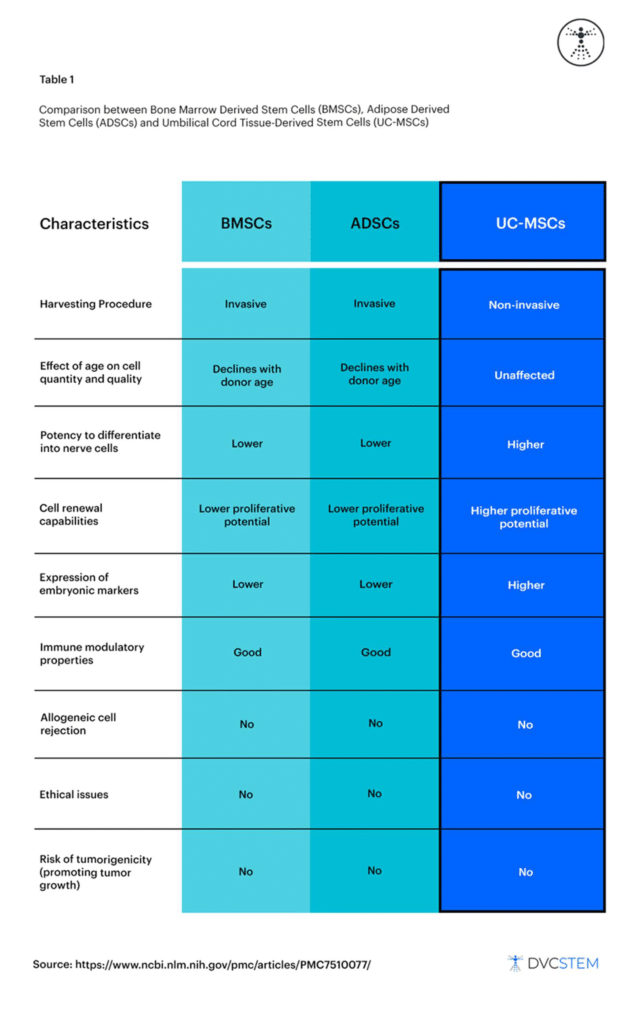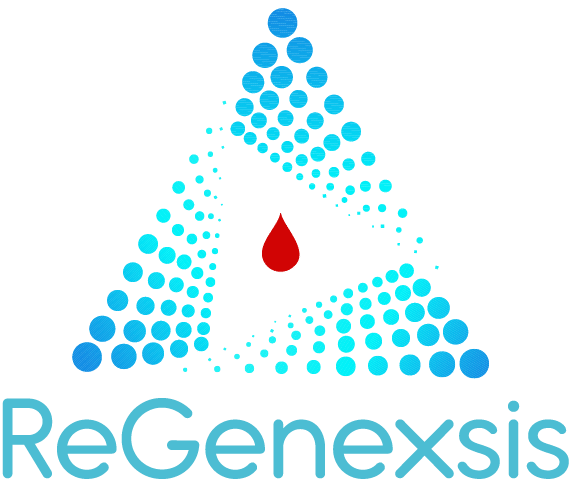What is Regenerative Medicine?
Regenerative medicine is a holistic approach designed to repair and rejuvenate damaged tissues like tendons, ligaments, cartilage, and bones. Unlike traditional pain management that often only masks discomfort, regenerative medicine focuses on actual healing by encouraging the body’s natural repair processes. Using powerful elements such as stem cells, growth factors, and platelets. This therapy promotes tissue regeneration, aiming for long-term recovery and improved health rather than just temporary relief.
How Do Stem Cells Work?
Stem cells are unique cells capable of regenerating and transforming into different cell types. When injected, they respond to signals from damaged tissues, initiating the healing process. Mesenchymal Stem Cells (MSCs), commonly sourced from Wharton’s Jelly in the umbilical cord, are known for their ability to become various cell types. These cells promote effective repair and restoration of damaged areas by reducing inflammation, modulating the immune system, and directly stimulating tissue regeneration.
Are stem cell injections safe?
Regenerative medicine therapies are non-surgical procedures that take a minimal amount of time, are proven to have faster recoveries, are completely natural and do not require pain medications. Additionally, over the course of hundreds of studies and thousands of treatments, there have been no reports of any longterm negative side effects. Regenerative medicine therapies use stem cells, their derivatives along with Peptides and other treatments to help heal, regenerate tissue and decrease inflammation to improve your quality of life.
Is there any chance my body rejects mesenchymal stem cells (MSCs)?
MSC Stem Cells have a degree of immuno-suppressive activity and thus are not usually subject to the same immune response as other foreign cells. Mesenchymal stem cells derived from umbilical cord tissue are universally accepted and have no chance of rejection. Wharton’s Jelly, found in Cord tissue, derived MSCs are essentially “brand new” and immuno-privileged, unclaimed by the body. Additionally, unlike other procedures such as organ transplants, there are no blood products used, and there is no HLA matching required.
Do Stem Cells Get Trapped in the Lungs? (Pulmonary First Pass Effect)
Mesenchymal stem cells (MSCs), particularly those from umbilical cord tissue (Wharton’s Jelly), are designed to avoid significant entrapment in the lungs due to their ideal size and natural circulation abilities. While some MSCs may initially pass through the lungs, their strong homing instincts allow them to quickly target areas of injury and inflammation. This brief presence in the lungs doesn’t reduce their therapeutic effects; instead, they release helpful signals that support healing throughout the body, enhancing their regenerative potential.
Can stem cells help prevent aging?
With current advancements in stem cell research, it's becoming more feasible to delay aging and improve overall health and longevity. Stem cells, especially when combined with anti-aging factors, create a protective barrier against the effects of aging. Through the rejuvenation of tissues, promoting cellular repair, and maintaining balance in gene expression related to aging, stem cells act as a vital defense against age-related decline. Studies suggest that stem cell therapies could significantly delay the aging process leading to improved health and a longer lifespan. The benefits of a stem cell reverse aging:
• A feeling of vitality and rejuvenation
• Improved capacity for physical activities
• Thickening and improved quality of hair
• Increased libido
• A decrease in pain
• Increased strength, balance & overall mobility
• Enhanced immunity
• Overall improvement in the quality of life
• Immune system regulation
• Decreased inflammatory markers.
Are there ethical issues involving this form of stem cell therapy?
The usage of Wharton’s Jelly derived Mesenchymal Stem Cells is not subject to the same ethical concerns as fetal and embryonic stem cells since. This tissue would be otherwise discarded. Both the Catholic Church and the Southern Baptist Convention have released statements supporting research and application of Wharton’s jelly stem cells in human disease treatment as an ethically acceptable substitute to fetal and embryonic stem cells.
What are Stem cells?
Stem cells are a special type of cell with the ability to differentiate into various specialized cell types in the body. This capability allows them to develop into cells of different tissues and organs, giving them significant healing, repair and therapeutic potential.
What are exosomes?
Exosomes are small extracellular vesicles released by most cells in the body, they contain various types of biological molecules, such as proteins, nucleic acids, and lipids. They transport genetic information and signals between cells. Think of Stem cells like the construction workers and exosomes like the construction plans or blueprints.
What is the benefit of Umbilical Cord cells as opposed to your own (Autologous) Cells from adipose (fat tissue) or bone marrow?
The harvesting procedure of UC-MSCs is noninvasive as it does not require extraction from the patient. The UC-MSC’s are taken directly from an area of an ethically donated human umbilical cord (Wharton’s Jelly). UC-MSCs also have a higher proliferative potential than B(one)MSC’s and A(dipose tissue) MSC’s. Meaning they expand in vitro more eectively, allowing for greater efficiency and better results. Please see chart below:

How does a hyperbaric chamber work and what are its benefits?
It is a pressurized space that delivers high concentrations of oxygen to a patient to treat a variety of conditions. The increased air pressure in the chamber helps the lungs collect more oxygen, which is then carried to the body's tissues and organs. This can help heal wounds, boost immune system, generate Stem Cells, improve brain function, fight infections, and reduce swelling.
What are Peptides and how does it benefit?
Peptides are short chains of amino acids that perform many important functions in the body, including:
• Digestion: Peptides help the body digest food and use its energy
• Hormones: Peptides help hormones function
• Cell movement: Peptides help cells move
• Wound healing: Peptides help wounds heal
• Brain function: Peptides help with brain function and mental health
• Skin health: Peptides are the building blocks of collagen, elastin, and keratin, which
are proteins that give skin its strength, texture, and resilience
• Muscle health: Peptides can help build muscle and enhance athletic performance
How long does it take to see results?
Study participants have reported measurable results within a few weeks and most within 3-6 months following treatment. This is indicated by a marked reduction in levels of systemic inflammation, reduced pain, increased flexibility, and changes in general vitality. However, it is common for patients to report improvements in their quality of life and a lessening of their original symptoms within the first few weeks following their infusion and injections. However, every patient is unique and may respond to the study differently.
How long do the effects of stem cells last?
Patient response is dependent on a large variety of biological factors; however, it is subject to the behavior and lifestyle of the patient. Patients who adhere to an active lifestyle, avoid additional injuries or re-injury, follow an anti-inflammatory diet, restrict the consumption of alcohol, tobacco, and caffeine can see sustained results for 3+ years, depending on condition. On average, patients have reported little signs of regression following their infusion and patients rarely return to their original state.
Please note: every patient is different and responds to treatment in their own way. There is currently no way to accurately predict the results of any stem cell infusion. We highly encourage prospective patients to do their research before pursuing this study. It is still a new, but promising field for treating many conditions which could otherwise not be treated.
Onboarding
What information do you require prior to scheduling a treatment date?
To ensure patient safety and efficacy, we require all patients to complete panel lab tests that may include medical exams and imaging prior to final clearance. The information provided will allow our medical team to establish a baseline for your pre-infusion status. These tests are preferred to be completed prior to your arrival in Colombia. (If rare circumstances arise that the test cannot be done at your hometown, we can accommodate and oer all lab tests including imaging locally in our facility. Patients must arrive for 2-3 days prior to treatment to allow time for results to be evaluated.) The specific requirements will be provided in detail via email after the initial screening application has been completed. Additionally, we have a patient management team that is available to help answer any questions related to the onboarding process.
How do I begin the onboarding process?
To determine candidacy, we request that all patients complete an application online. This screening application will give our medical team the preliminary information needed to determine which protocol and treatment the applicant may be a candidate for. We have a three-step onboarding process every patient must follow prior to final clearance:
Step 1: Complete Screening Application
Step 2: Complete Patient Intake Forms
Step 3: Complete Video Consultation
